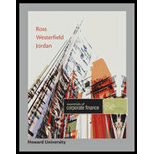
a)
To determine: The Treasury bills average return and the average inflation rate for the period from 1973 to 1980.
Introduction:
The rate at which the inflation increases is the inflation rate. The Fisher effect helps to establish a relationship between the nominal
a)
Answer to Problem 22QP
Explanation of Solution
Given information:
The T bill return for the years 1973 is 0.729, 1974 is 0.799, 1975 is 0.0587, 1976 is 0.507, 1977 is 0.0545, 1978 is 0.0764, 1979 is 0.1056, 1980 is 0.1210.
The inflation rates as follows:
For the year 1973 is 0.087, 1974 is 0.1234, 1975 is 0.0694, 1976 is 0.0486, 1977 is 0.0670, 1978 is 0.0902, 1979 is 0.1329, 1980 is 0.1252.
The formula to compute the average return of the Treasury bills:
Compute the average real return of the Treasury bills:
Hence, the average return of Treasury bill is7.75%.
Determine the average inflation rate:
The formula to calculate the averageinflation rate of the treasury bills:
Hence, the average inflation rate is 9.30%.
b)
To determine: The standard deviation of Treasury bill returns and inflation over this time period.
Introduction:
Arithmetic average return refers to the returns that an investment earns in an average year over different periods. Variance refers to the average difference of squared deviations of the actual data from the mean or average. Standard deviation refers to the deviation of observations from the mean.
b)
Answer to Problem 22QP
Explanation of Solution
Given information:
The T bill return for the years 1973 is 0.729, 1974 is 0.799, 1975 is 0.0587, 1976 is 0.507, 1977 is 0.0545, 1978 is 0.0764, 1979 is 0.1056, 1980 is 0.1210.
The inflation rates as follows:
For the year 1973 is 0.087, 1974 is 0.1234, 1975 is 0.0694, 1976 is 0.0486, 1977 is 0.0670, 1978 is 0.0902, 1979 is 0.1329, 1980 is 0.1252.
The formula to calculate the standard deviation of Treasury bill returns:
“
“
“
“N” refers to the number of observations.
Compute the sum of squared deviations of T-bill:
| T-bill | ||||
| Year (A) | Actual return (B) | Average return (C) |
Deviation (B)–(C)=(D) | Squared deviation(D)2 |
| 1 | 0.0729 | 0.0775 | -0.7021 | 0.49294441 |
| 2 | 0.0799 | 0.0775 | -0.6951 | 0.48316401 |
| 3 | 0.0587 | 0.0775 | -0.7163 | 0.51308569 |
| 4 | 0.0507 | 0.0775 | -0.7243 | 0.52461049 |
| 5 | 0.0545 | 0.0775 | -0.7205 | 0.51912025 |
| 6 | 0.0764 | 0.0775 | -0.6986 | 0.48804196 |
| 7 | 0.1056 | 0.0775 | -0.6694 | 0.44809636 |
| 8 | 0.121 | 0.0775 | -0.654 | 0.427716 |
|
Total of squared deviation
| 0.004310 | |||
Hence, the squared deviation of the T-bill is 0.004310.
Compute the standard deviation:
Hence, the standard deviation of the T-bill is 0.0248 or 2.48%.
Compute the standard deviation of inflation:
The formula to calculate the standard deviation of inflation:
“
“
“
“N” refers to the number of observations.
Compute the sum of squared deviations of inflation:
| Stock | ||||
| Year (A) | Actual return (B) | Average return (C) |
Deviation (B)–(C)=(D) | Squared deviation(D)2 |
| 1 | 0.0871 | 0.093 | -0.0059 | 0.00003481 |
| 2 | 0.1234 | 0.093 | 0.0304 | 0.00092416 |
| 3 | 0.0694 | 0.093 | -0.0236 | 0.00055696 |
| 4 | 0.0486 | 0.093 | -0.0444 | 0.00197136 |
| 5 | 0.067 | 0.093 | -0.026 | 0.000676 |
| 6 | 0.0902 | 0.093 | -0.0028 | 0.0000078 |
| 7 | 0.1329 | 0.093 | 0.0399 | 0.00159201 |
| 8 | 0.1252 | 0.093 | 0.0322 | 0.00103684 |
|
Total of squared deviation
| 0.006799 | |||
Hence, the squared deviation is 0.006799.
Compute the standard deviation:
Hence, the standard deviation is 0.031 or 3.11%.
c)
To determine: The real return for every year.
Introduction:
The real rate of return refers to the rate of return on an investment after adjusting the inflation rate.
c)
Answer to Problem 22QP
Explanation of Solution
The formula to calculate the real rate using Fisher’s relationship:
Where,
“R” is the nominal risk-free rate of return,
“r” is the real rate of return,
“h” is the inflation rate.
The formula to calculate the average real return of the treasury bills:
Compute the real return for each year:
For 1973:
For 1974:
For 1975:
For 1976:
For 1977:
For 1978:
For 1979:
For 1980:
Compute the average real return:
Hence, the average real return is -1.40%.
d)
To discuss: The potential risks of Treasury bills.
d)
Explanation of Solution
T-bills are usually risk free items as they are normally short-term. They also held with limited interest rate risk. If the investors are earning positive nominal return, which will decline the inflation risk ultimately.
Want to see more full solutions like this?
Chapter 10 Solutions
ESSENTIALS OF CORP.FIN.-W/CODE >CUSTOM<
 Essentials Of InvestmentsFinanceISBN:9781260013924Author:Bodie, Zvi, Kane, Alex, MARCUS, Alan J.Publisher:Mcgraw-hill Education,
Essentials Of InvestmentsFinanceISBN:9781260013924Author:Bodie, Zvi, Kane, Alex, MARCUS, Alan J.Publisher:Mcgraw-hill Education,

 Foundations Of FinanceFinanceISBN:9780134897264Author:KEOWN, Arthur J., Martin, John D., PETTY, J. WilliamPublisher:Pearson,
Foundations Of FinanceFinanceISBN:9780134897264Author:KEOWN, Arthur J., Martin, John D., PETTY, J. WilliamPublisher:Pearson, Fundamentals of Financial Management (MindTap Cou...FinanceISBN:9781337395250Author:Eugene F. Brigham, Joel F. HoustonPublisher:Cengage Learning
Fundamentals of Financial Management (MindTap Cou...FinanceISBN:9781337395250Author:Eugene F. Brigham, Joel F. HoustonPublisher:Cengage Learning Corporate Finance (The Mcgraw-hill/Irwin Series i...FinanceISBN:9780077861759Author:Stephen A. Ross Franco Modigliani Professor of Financial Economics Professor, Randolph W Westerfield Robert R. Dockson Deans Chair in Bus. Admin., Jeffrey Jaffe, Bradford D Jordan ProfessorPublisher:McGraw-Hill Education
Corporate Finance (The Mcgraw-hill/Irwin Series i...FinanceISBN:9780077861759Author:Stephen A. Ross Franco Modigliani Professor of Financial Economics Professor, Randolph W Westerfield Robert R. Dockson Deans Chair in Bus. Admin., Jeffrey Jaffe, Bradford D Jordan ProfessorPublisher:McGraw-Hill Education





